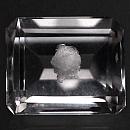|
Click on a letter above to view the list of gems. |
|
|
|
|
|
|
|
|
Cleavelandite
(a
variety of Albite) (inclusions
in Quartz) |
|
| | |
| Discovered in 1815 (Albite). IMA status: Not Valid (Cleavelandite is a variety of Albite) | ||
|
| ||
|
Chemistry |
|
|
| |
|
Na[AlSi3O8] | |
|
|
Sodium Aluminum Silicate |
|
Molecular Weight: |
263.02 gm |
|
Composition: |
Soldium |
8.30 % |
Na |
11.19 % |
Na2O |
|
|
Calcium |
0.76 % |
Ca |
1.07 % |
CaO |
|
|
Aluminum |
10.77 % |
Al |
20.35 % |
Al2O3 |
|
|
Silicon |
31.50 % |
Si |
67.39 % |
SiO2 |
|
|
Oxygen |
48.66 % |
O |
|
|
|
|
|
100.00 % |
|
100.00 % |
= TOTAL OXIDE |
|
|
|
||||
|
Classification |
|
|
| |
|
Silicates (Germanates) | |
|
8/J.07-20 | |
|
|
9 : SILICATES (Germanates) |
|
Related to: |
Variety of Albite. Feldspar Group. Plagioclase Series. Na-rich end member of the Albite-Anorthite Series. Low- and high-temperature structural modifications exist. Low- and high-temperature structural modifications are recognized. |
|
Synonyms: |
Clevelandite |
|
|
|
|
Crystal Data |
|
|
|
|
|
(Albite) Crystals commonly tabular || {010}, may be curved, to 3 cm; divergent aggregates, granular, cleavable massive. |
|
|
(Albite) Common around [010] or {010}, giving polysynthetic striae on {001} or {010}; many other laws, contact, simple and multiple. |
|
|
|
|
|
Physical Properties |
|
|
|
|
|
Perfect on {001}, very good on {010}, imperfect on {110} |
|
|
Irregular/Uneven to Conchoidal |
|
|
Brittle |
|
|
6.0 - 6.5 |
|
|
2.60 - 2.65 (g/cm3) |
|
|
Fluorescent, Short UV=cherry-red blue, Long UV=white. |
|
|
Not Radioactive |
|
|
Other: |
F |
|
|
|
|
Optical Properties |
|
|
|
|
|
White to Gray, Bluish, Greenish, Reddish; may be chatoyant. |
|
|
Transparent to Translucent |
|
|
Vitreous, Pearly on cleavages |
|
|
1.528 - 1.542 Biaxial ( + ), Biaxial ( - ) for high variety |
|
|
0.0090 - 0.0100 |
|
|
Weak; r < v |
|
|
None |
|
|
|
|
|
Occurances |
|
|
|
|
|
Geological Setting: |
A major constituent of granites and granite pegmatites, alkalic diorites, basalts, and in hydrothermal and alpine veins. A product of potassium metasomatism and in low-temperature and low-pressure metamorphic facies and in some schists. Detrital and authigenic in sedimentary rocks. |
|
Common Associations: |
Quartz, Orthoclase, Muscovite, Biotite, "Hornblende" |
|
Common Impurities: |
Ca, K, Mg |
|
Type Locality: |
(Albite) Finnbo (Finbo), Falun, Dalarna, Sweden |
|
Year Discovered: |
(Albite) 1815 |
|
View mineral photos: | |
|
|
|
|
More Information |
|
|
|
|
|
|
Mindat.org
(Cleavelandite) |
|
|
|
|
|
|
|
We
have not photographed our Cleavelandite gems. Please
check back soon. |
